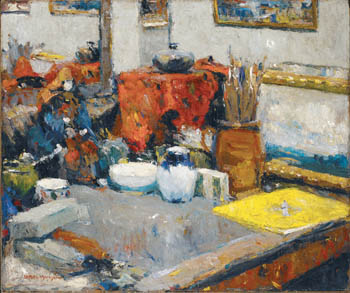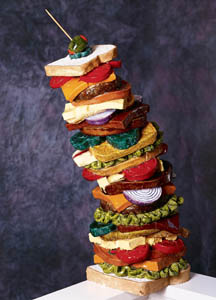![[Metroactive Arts]](/arts/gifs/art468.gif)
[ Arts Index | Silicon Valley | Metroactive Home | Archives ]
Objects on the Go
California artists redefine the still life in a bold new show at the San Jose Museum of Art
By Michael S. Gant
THE STILL-LIFE genre proves to be a very mobile target at the San Jose Museum of Art's newest show. The French, as usual, have a better name: nature morte. Dead nature. Not just objects at rest, but expired things: plucked fruit, picked flowers, fish out of water, pheasants and hares ready for dressing and roasting.
Arranged on a tabletop, these stationary objects provide artists an opportunity to study form, light and color without having to wrestle with issues of meaning. As such, the still-life tradition that started with Dutch and Flemish painters in the 16th and 17th centuries was considered bottom genre in the artistic pecking order, trailing behind history paintings, portraits and landscapes.
After Impressionism and, especially, Cubism, the still life became more malleable--fair game for every new -ism from Tonalism to Surrealism--and even migrated from the picture plane to the pedestal as sculpture. The how became more important than the what.
The "Not-So-Still Life," a stimulating new show curated by Susan Landauer, William Gerdts and Patricia Trenton, explores the multitude of ways artists in California remade the genre in their own images in the 20th century. The chronologically arranged exhibit (and the sumptuous catalog published by the museum and UC Press) restores the still life to a place of honor in California art history alongside the landscape, and highlights some artists in need of deeper study.
The exhibit begins conventionally enough with the flower paintings of Alice B. Chittenden, Jules Pagès, Paul de Longpré and others. These traditional still lifes--with cut blossoms spilling from vases and baskets placed on table surfaces that function as domestic horizon lines--burst with a sense of the young state's potential. California, particularly Southern California, was undergoing an unprecedented population explosion, and developers extolled the state's virtues, particularly its salubrious climate.
Early in the century, Alberta and William McCloskey specialized in fruit paintings, and their still lifes depicted what were to most of the country exotic citrus fruits. William McCloskey's 1912 oil of tangerines and grapes (illustrated in the catalog but not the show) recalls the luxurious still lifes of lemons and oranges by Zurburán, the 16th-century Spanish painter--and, more prosaically, the brilliantly colored fruit-crate labels of the period.
Trained in France, de Longpré moved to Los Angeles in 1899 and promoted himself as a celebrity painter, living in a Moorish mansion near Hollywood Boulevard. He is represented by Rambling Roses, an exquisite watercolor from 1908. This bough of blooms is rendered against a white backdrop, more like a nature or botanical study than a traditional arranged still life. Adding a hint of movement, two bumblebees hover nearby.
Also departing from the norm is Franz Bischoff, whose White and Pink Maman Cochet-Roses shows in its quick brush strokes the influence of Impressionism, which came late to the insular world of California art. Especially interesting is Bischoff's Porcelain Vase With California Poppies, an elegantly outward tapering celadon vessel decorated with long-stemmed poppies. It's the first instance in the show of the shift from the 2-D painted still life to the 3-D sculptural still life.
In a different kind of departure from tradition, Joseph Kleitsch's 1925 oil Highlights functions as a portrait, using some of the artist's favorite things--a violin, an accordion, some books, a painting resting against a wall--to express his personality. Armin Hansen's 1917 oil My Worktable lays out the tools of the artist's trade, rendered in liquid daubs that give the piece a watery surface.
The human figure invades the realm of objects in Paul Grimm's 1928 oil Protection. An eerily oversized doll (or is it really an expressionless young girl?) sits on a sofa flanked by two slightly menacing stuffed animals. The painting anticipates the creepy fetishized nudes of children that made Balthus a scandal. In George Brandriff's Ebb-Flow (1934), two wooden dolls in Russian folk garb loom over a map and some upturned French soldier toys, in effect turning the still life into a political allegory. Both Selden Gile and Miki Hayakawa place their objects in front of open windows, allowing them to create landscapes as well as still lifes.
In the second part of the show (covering the years 1920 to 1950), the still life roils with personal symbology. Henrietta Shore, in Gloxinia by the Sea (1930), perches a realistic potted plant on a railing hovering against a vague expanse of blue-gray sea fading into slate-gray sky with muted white cumulus clouds, creating a sense of imbalance and uneasiness. What at first appears representational begins to convey a guarded emotional secret the longer you look. Even better is Shore's Cactus (1926-27), an engorged, ribbed form with spines like the waving cilia on a sea creature. Less successful is Lucien Labaudt's Shampoo at Moss Beach (1935), which looks like warmed-over Dali.
Veering in a hermetic direction, Agnes Pelton embodies California's continuing fascination with metaphysical cults like Theosophy in her large canvases of celestial vases riding on cosmic waves and emitting tendrils of white vapors against starry backgrounds. They function as meditative dream states, with the keys to understanding closely held by the artist.
By the end of the 1940s, the influence of nonrepresentational modernism grows so strong that a painting like Jules Engel's The Vase, a jigsaw puzzle of red, brown and yellow angular forms, is a pure abstraction, with only the title to clue us to any vestiges of a still life.
The final third of the show demonstrates how the Bay Area Figuratives, like Richard Diebenkorn and David Park, reacting against the onslaught of Abstract Expressionism from New York, returned to the still life, using simple subjects like hairbrushes and coffee cups to experiment with composition and color.
In the 1960s, with the emergence of pop art, a whole new army of manmade objects march into still lifes, from Wayne Thiebaud's ice cream sundaes to Martha Alf's toilet paper rolls rendered with all the skill of a Renaissance master. Soon, the still life becomes fair game for self-referential tributes, from Charles Griffin Farr's Watermelon and Knife, which could be a late-19th-century trompe l'oeil still life, to David Gilhooly's The Leaning Tower of Dagwood, a brightly colored ceramic of a massive, oozing sandwich that laughs at the idea of genres.
By the end of the show, the idea of still life has been so thoroughly attacked from every angle, that anything goes--paintings, sculptures scaled to Claes Oldenburg size, assemblages, electronic art. Chester Arnold, in Accumulation (1998), paints a mountain of debris representing every object he can remember owning--the still life as landfill. Peter Saul's Still Life #1 (1996) is a Robert Crumb-like riot of globby anthropomorphic objects (squirting paint tubes, a sweating alarm clock with arms) attacking each other in a cartoon melee. F. Scott Hess' series of hyperrealistic scenes from a murder mystery uses still-life objects as clues in a narrative as fraught with meaning as any history painting.
Fittingly, "The Not-So-Still Life" ends (and begins, since the painting is mounted in the stairwell leading to the upstairs gallery) with Chris Brown's Decker's Memory (1992), a large canvas depicting a branch full of golden pears. The painting looks back to the still lifes of 19th-century American artist Joseph Decker, but the horizontal smear of the brushstrokes makes these pears look like something glimpsed out of the window of a speeding car. The life remains still; it's the viewer who is in motion.
[ Silicon Valley | Metroactive Home | Archives ]
Copyright © Metro Publishing Inc. Metroactive is affiliated with the Boulevards Network.
For more information about the San Jose/Silicon Valley area, visit sanjose.com.
![]()

Table of Contents: Armin Hansen's 1917 oil painting 'My Worktable' uses the conventions of the still life to create a portrait of the artist from his tools.

Slice of Still Life: David Gilhooly's 'Leaning Tower of Dagwood' mocks genre distinctions.
The Not-So-Still Life: A Century of California Painting and Sculpture runs through Feb. 15 at the San Jose Museum of Art.
Send a letter to the editor about this story to letters@metronews.com.
From the December 4-10, 2003 issue of Metro, Silicon Valley's Weekly Newspaper.